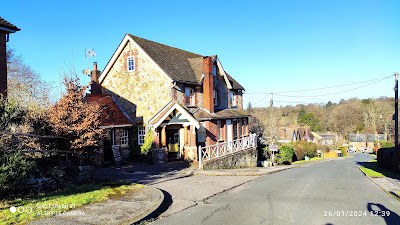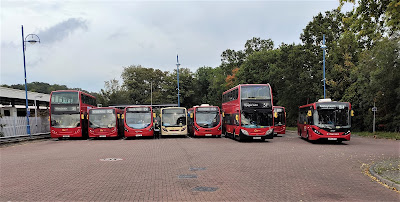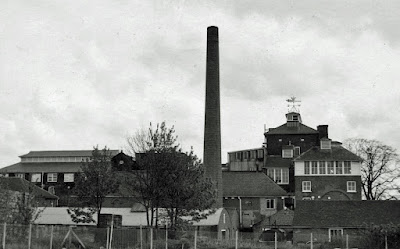The Dark and Delicious Winter Beer Festival, held at the Cooper’s Arms, Crowborough, is an annual event hosted by the pub at the end of each January, and normally features a dozen or so strong, “winter ales”, most of them on the dark side, although not exclusively so. This year’s festival was the first I have attended since before the pandemic, and it largely followed, the pattern set by previous events. The Cooper’s Arms is an attractive 19th Century pub perched on the side of a hill, in an affluent residential area to the west of Crowborough. It is constructed partially from brick and local stone, and is situated in a quiet side road, which falls away sharply as you turn into it. As the road starts to descend further, there are some quite spectacular views towards the edge of Ashdown Forest; a reminder, if one was needed, that at 787 ft above sea level, Crowborough is the highest town in South East England.
The Cooper’s is a former Charrington’s tied house, and back in the day, served a very acceptable pint of Draught Bass. It also offered good food, as I discovered when I was taken there for lunch by Brian, the owner of the printers my company used at the time. After working closely with Brian, we both realised our mutual appreciation of good beer and good pubs, and because of this he was keen to show off his local. Straight away I could see why he liked the Cooper’s, although after 35 years, there has been quite a few changes.
Friday 25th saw myself and a group of friends boarding the No. 29 bus at Five Ways in Tunbridge Wells, alighting in the centre of Crowborough at the Cross. As mentioned earlier, the town is the highest in the south-east, and it is also one of the most spread out. Despite the welcome winter sunshine, there was a rather keen wind blowing as we crossed the road, and I was certainly glad that I’d donned an extra layer of clothing before leaving the house. It’s quite a trek to the Cooper’s from the centre of Crowborough, and if you are on foot, it’s one of those walks where you keep thinking the pub is just around the next corner, or just over the brow of the next hill. It’s mainly downhill as well, passing through a mixed residential area of quite substantial modern houses, interspersed with older, and rather posh looking Victorian dwellings. Around virtually every corner there are splendid views out towards the flanks of Ashdown Forest, but eventually after about 20 minutes of brisk walking, a turning on the right (Cooper’s Lane), leads to the pub which the road is named after. I stopped to take a few photos, before entering, and was pleasantly surprised that the place had been given a long overdue makeover. Internally there is one long and quite narrow bar, which opens up at both ends. Arriving on a Friday, meant there were plenty of unoccupied chairs and tables, so after laying claim to a spot close to the wood burner, we approached the bar to see what beers were on sale. There was a dozen carefully selected beers, most of them dark in nature, such as porters, stouts, brown or old ales. Breweries that featured prominently, included Burning Sky and Goacher’s, with contributions from Arkells, Kernel and Tonbridge. Tucked away, in a narrow alcove on the customers’ side of the bar, was another bank of four hand pumps, dispensing the stronger stuff, with a couple of aged casks from Dark Star (Critical Mass) and Moor Beer (Old Freddy Walker). More on that later.
Our party of six, had grown to ten with the presence in the pub of another group of local CAMRA members, and after we’d all settled down, got stuck into the beers, and were deep in various interlinked conversations, that thoughts turned to something to eat. According to the pub’s website, food would be available between midday and 3pm. But with no sign of anything to eat, I asked the landlord as to when some solid sustenance might be available. He said that whilst there would not be any hot food, a selection filled rolls would be forthcoming, although with time wearing on, and no sign of any rolls, most of us had decided to make do instead with the old fallback of crisps and peanuts.
The lack of anything to eat was in sharp contrast to the event that took place in 2016 when, as reported here, there were stacks of wrapped and pre-prepared cheese and onion rolls at each end of the bar, and the kitchen staff were kept busy serving either pasties or sausage and chips. I'm not sure what happened this time around, although as the landlord was there on his own, it may well have been down to staffing issues. Comments the next day, on social media from a number of CAMRA members who attended the festival on Saturday, reported the presence of a food truck parked at the rear of the pub, which at least solved the issue of something solid, to soak up the beer.
Beer-wise, there was an excellent selection of mainly dark beers, served in good condition and sold at reasonable prices. There was a nice and convivial atmosphere inside the pub, although the clientele was almost exclusively male. As far as I was concerned, Burning Sky delivered the outstanding beers of the festival, in the form of their Porter, plus their 5.9% Blended Export Stout. For the connoisseurs amongst you, the latter had a touch of Brettanomyces - "Brett" which imparts a slight sour touch to the beer which, in small quantities, and when set against the main background flavours of the finished beer, gives it a refreshing edge.
I’d never really got the "Brett" thing before, but I certainly did this time around, and for this reason this Blended Export Stout was “beer of the festival” for me. I didn’t get to try the Old Freddy Walker from Moor Brewery near Bristol, a full-bodied, rich, and dark, 7.3% abv strong ale. As at previous festivals, mine host had laid down a cask of this beer to age in the pub’s cellar, for a year. I didn’t try this year’s version, but the example sold in 2016 was a stunning beer, and I was not the only one to state, back then, that it was the best beer of the day.Apart from at special events, such as festivals, the Cooper's has limited weekday opening times, and is closed altogether,
from Monday through to Wednesday. I imagine this is a sign of the times, although it is in sharp contrast to that occasion, 35 years ago, when my printer friend treated me for lunch at the pub. The Cooper's opens
at 5pm Thursday-Saturday, and 3pm on Sundays, although possibly that may change, come the summer. Unfortunately, its current restricted opening does rule out a daytime visit, with the exception of Sunday afternoon, which is a great shame, but perhaps reflects changing times and changing social habits.















.jpg)


.jpg)





































